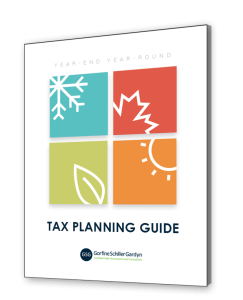The Tax Cuts and Jobs Act mandated that exempt organizations include expenses related to qualified transportation fringe (QTF) benefits as unrelated business taxable income (UBTI).
QTF benefits include transit passes and qualified parking, whether provided directly by the employer, through a bona fide reimbursement arrangement, or through a compensation reduction agreement. Qualified parking is defined as a parking facility on or near the organization’s premises and provided to employees for their use.
The potential qualified parking inclusion as UBTI, in particular, caused an uproar in the exempt organization community. In December 2018, the IRS released long-awaited guidance, in Notice 2018-99, to delineate the circumstances in which parking expenses would be taxable as UBTI.
As a result of the guidance provided, fewer exempt organizations will be subject to unrelated business income tax on parking expenses than originally anticipated. Note that the IRS intends to issue proposed regulations, but exempt organizations may rely on the notice in the interim.
The notice enumerates parking expenses subject to inclusion as UBTI in the following two categories:
Organization pays a third party for employee parking:
If money is paid to a third party so employees can park in the third party’s garage or lot, the amount paid to the third party is a parking expense. This type of parking expense is automatically an employee-related parking expense and is UBTI, subject to one exception: The amount paid to the third party is not UBTI to the extent it exceeds the statutory limit for exclusion from employee wages, which was $260 per employee in 2018. In that case, any amounts above the exclusion maximum are not UBTI if properly included in employee wages.
Organization owns or leases parking facility:
If a taxpayer owns or leases a parking facility, parking expenses include (but are not limited to) repairs, maintenance, utility costs, insurance, property taxes, interest, snow and ice removal, leaf removal, trash removal, cleaning, landscape costs, parking lot attendant expenses, security, and rent or lease payments or a portion of a rent or lease payment (if not broken out separately). Note that depreciation on a parking structure is not considered a parking expense for this purpose.
These parking expenses are only UBTI to the extent they relate to employee parking. Expenses paid for parking made available to the general public, rather than to employees, are not UBTI.
The general public includes customers, clients, visitors, patients, students, individuals delivering goods, and congregants of a religious organization. It does not include employees or independent contractors of the organization.
To be considered available to the general public, parking needs to be reserved for the public or needs to be unreserved and is actually used by the public. The notice provides that for this purpose, empty spots are considered to be used by the public. Therefore, parking expenses allocated to unreserved spots that are either empty or used by the public will not generate UBTI.
The notice also sets forth a “primary use test,” which is a key factor in reducing the number of exempt organizations subject to UBTI on parking expenses: If the majority of a parking facility, excluding employee-reserved spots, is used by the public, all of the unreserved spots in the facility are considered to be available to the general public.
No UBTI needs to be calculated for those unreserved spots even if some employees park in them. Primary use is tested during the normal hours of the exempt organization’s activities on a typical day.
Parking spots reserved for employees are, by definition, employee parking, and parking expenses allocated to those spots UBTI. However, since this notice was issued late in the year, it provides a special rule for reserved employee spots. Employee spots that were reserved but are changed to be unreserved by March 31, 2019 are considered to be unreserved retroactively going back to January 1, 2018.
Until regulations are issued, any reasonable method can be used to calculate employee vs public use of parking spots and to allocate parking expenses between those two categories.
The notice explains one reasonable method for this allocation, which involves a four-step process:
Step 1: Count the total number of parking spaces in the organization’s parking lot or facility (or portion of a lot or facility allowed to be used by the organization), and count the number of parking spaces that are reserved exclusively for employees. Spots can be reserved in several ways, including with a sign or through limited access to the spots (e.g. access granted only with an employee pass). Calculate the proportion of employee-reserved spots to total spots and multiply by total parking expenses to arrive at the first portion of UBTI from employee-related parking expenses.
Step 2: Examine whether the remaining parking spots that are not reserved exclusively for employees are used primarily by the general public during the organization’s normal hours of operation. Any reasonable method can be used to make this determination. Primary use refers to greater than 50%, and, as mentioned above, spots that are empty are considered used by the public. If the primary use of those remaining spots is determined to be public use, stop here, and your calculation is finished. No UBTI needs to be calculated for unreserved parking spots used by employees. If the primary use is not public use, move to Step 3.
Step 3: Count the number of spots reserved for non-employees (e.g. reserved for students or customers). If there are no spots reserved for non-employees, move to Step 4. If there are spots reserved for non-employees, calculate the proportion of non-employee reserved spots to total spots excluding employee-reserved spots. Multiply that proportion by remaining parking expenses not included in UBTI in Step 1. This amount is automatically not UBTI.
Step 4: Determine the percentage of unreserved parking spots used by employees during normal business hours of the exempt organization. Multiply by total parking expenses less expenses calculated as UBTI in Step 1 and less expenses calculated as non-UBTI in Step 3. The result is the second portion of UBTI from employee-related parking expenses.
The portions of parking expenses calculated in Steps 1 and 4 are both UBTI. Note that Form 990-T only needs to be filed if gross income from unrelated trades or businesses of the organization plus UBTI from parking expenses is $1,000 or more. Note as well that UBTI from parking expenses is not considered a separate trade or business of the organization and can be offset by losses from an unrelated trade or business conducted by the exempt organization. In addition, the specific deduction of $1,000, allowed for any net unrelated business taxable income on Form 990-T, can be used to reduce net UBTI created by parking expenses.
The IRS also announced in Notice 2018-100 that it will not charge the penalty for underpayment of estimated income tax for payments required to be made on or before December 17, 2018. The waiver only applies to the extent the underpayment results from the new treatment of parking expenses as UBTI. It also only applies to exempt organizations that were not required to file Form 990-T in the immediately preceding tax year.
As described above, Notices 2018-99 and 2018-100 provided some welcome guidance and relief for exempt organizations. Despite the relief, many exempt organizations previously not required to file Form 990-T will be required to start filing the form and to pay tax on UBTI for employee parking expenses. Others will be required to file as a result of providing transit passes or other QTF benefits aside from parking.
There is a proposal in Congress to repeal the new QTF expense UBTI provision, but its fate is uncertain. Please do not hesitate to contact one of our tax professionals with questions related to this notice.
Categories: Tax, Tax Planning, Not-for-Profit




